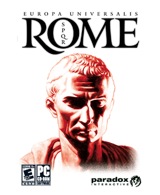Europa Universalis Rome – PC Game Review
 Europa Universalis Rome. Paradox Interactive. $59.99.
Europa Universalis Rome. Paradox Interactive. $59.99.
Passed Inspection: Great subject, deeply satisfying strategy gaming.
Failed basic: Information overload in later games and ping-pong warfare.
One new feature . . . is a heavy emphasis on personalities and dynasties.
Ancient Rome dominates the story of Western Civilization. The legions spread Roman laws, literature and religion across Europe, with sharp gladii and plenty of spilled blood. Likewise, Paradox dominates the world of historic strategy games; if you love strategy, you have probably played one of their great titles. Paradox’s latest game—Europa Universalis Rome—is certainly one of the publisher’s best titles. Like it’s namesake, the Roman Empire, EUR stands out among its peers and may also stand the test of time.
{default}One of the reasons Rome is such a good game is the excellent choice of subject matter. It spans one of the most dynamic periods in Rome’s history, the roughly 250 years between the Pyrrhic Wars and the establishment of Augustus as the first emperor. During this time, Rome went from a mere regional contender to undisputed Mediterranean superpower. The story of this rise to empire is a compelling saga that is portrayed well by EUR.
Gameplay is vintage Paradox. Those familiar with previous Europa Universalis titles, or almost any other strategy title in Paradox’s stable, will know what they are getting. In the game, the player is responsible for running all aspects of a nation-state in the Ancient Mediterranean. Player can select any nation and timeframe, so when playing Rome becomes stale switching to barbarians or a Greek city-state is possible. The game plays in real time, on a region-based map. The game date advances day by day, but there is no time pressure since players can pause or speed up the action to their liking. While the game is technically real-time strategy, it is not a traditional RTS; those who like to play with lightning-fast mouse clicks, and split-second decision making will want to look elsewhere.
Europa Universalis Rome is a beautiful game, with great graphics and a stirring soundtrack that rivals even the best of Hollywood’s sword-and-sandal flicks. The interface is very effective and polished, making a complex game easy to play. The map is full 3D and beautiful. The lush landscape of Europe, Persia and North Africa, is easy to rotate and zoom with simple mouse movements. Land units are represented by 3D foot soldiers portraying each nation’s culture: the Romans have a legionnaire, the Greeks a hoplite, etc. Clicking on a region shows key data such as trade routes, culture and population. Clicking on an army shows the commander and break-down of the unit by troop type.
The main action in the game is military and diplomatic. The road to Great Empire is paved with the bones of foot soldiers—hopefully the enemy’s. The make-up of military units is fairly complex. Land units, called legions or stratos, are made up of a mix of many 1,000-man cohorts. These cohorts could be cavalry, horse archers, archers, militia, or heavy infantry. While names of these types change with each culture, the function and characteristics of each type are the same. Naval units, on the other hand, have only one type, the trireme. Movement on the board is by simple point-and-click command. Other unit functions, like reassigning cohorts and commanders, are also done easily with just a few clicks.
Combat occurs when two enemy units are in the same region. The calculation of battle is complex, taking into account different troop types, their experience, morale, terrain and the capabilities of the commanders. The player really has no input to the final result, and fighting keeps going until one side’s morale breaks. Once the enemy army is beaten, the winner almost always has to take the region by siege. While a commander can attempt to assault a fortified city, it is always difficult and costly. Cautious commanders will sit outside the walls and let the enemy starve, and this can easily take one or two game years before the fortification surrenders.
One distraction in an otherwise great game is the ping-pong effect that happens in many battles. After losing in combat, armies rarely shatter but instead take about 15% casualties and retreat, often into another enemy region. To destroy them, the victor must follow the retreating army to the new province, fight and win again. The loser then retreats back into the original province, where the victor must follow and win again. It is common for this back-and-forth, running combat to take six iterations before the enemy unit is destroyed. While the Ancient World certainly saw one army chasing another, sometimes for years, it also saw entire armies crushed and scattered in a day. So those dramatic scenes from history, where defeated generals fall on their swords and their army melts into oblivion, just don’t occur in EUR.
Games of chase aside, EUR does an excellent job of portraying the logistics of empire in the Ancient World. Rarely will the player be able to support enough troops to suppress rebellions and beat back barbarian invasions across the empire. Each region also has a limit to the number of armies it can support, and when this is exceeded, your legions start to slowly drain men. To add to this, marching times are realistic: It can take months for an army to move from Northern Italy, across the Alps and into Gaul. As the empire grows in size, the number of rebellions and barbarian invasions increase, so the successful player will have to quickly master the use of strong, well-placed legions, using naval transport to quickly move to hotspots.
[continued on next page]


0 Comments
Trackbacks/Pingbacks